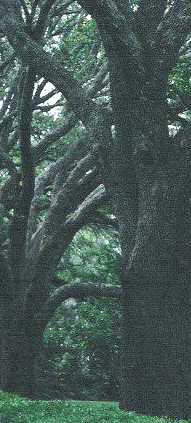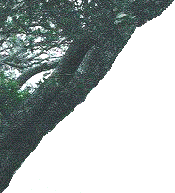Order olmesartan from indiaThe C1 arch blood pressure low range olmesartan 40mg with mastercard, base of dens blood pressure chart images buy discount olmesartan 40 mg on line, pre-dens space hypertension interventions 10 mg olmesartan mastercard, and lateral mass articulations are seen seventy six I Occipital-Cervical Junction arteriovenous fistula olmesartan 10 mg otc. Transverse Cervical Ligament the transverse ligament is a tricky, rather thick, delineated, pale yellow, ligamentous belt behind the dens. It is a information after the C1 arch and odontoid have been removed as a result of they may be obscured by the destructive adjustments of disease. The dura could additionally be densely adherent to the posterior floor of the transverse ligament and adjoining tectorial membrane. Sharp microdissection of the tectorial membrane is important to separate it from the underlying dura. Active bleeding from epidural veins can be troublesome but is ultimately controlled by bipolar coagulation and packing with topical hemostatic material. Anterior Rim Foramen Magnum the anterior rim of the foramen magnum and caudal basiocciput may be palpated and seen between the attachments of the longus capitis muscular tissues. These attachments can be separated to expose the bony parts for elimination if required. A gap drilled into the clivus rostral to the anterior rim can serve as an anchor site for rostral delicate tissue retraction, as illustrated in. The laser, controlled through the microscope attachment, facilitates this dissection. This bone ridge can additionally be drilled away if necessary for lesion publicity or neural decompression. The ipsilateral C1-C2 lateral mass articulation is more forward and could be mistaken for the anterior arch of C1, leading to disorientation. The anatomy of this region has been well described and should be acquainted to the surgeon. The dens is removed starting on the apex, working caudally, keeping the bottom intact for management and orientation. Otherwise the tip of the dens can turn into disconnected and the freely cellular bone could cause injury to underlying constructions while being removed. After the bone has been thinned like an eggshell, a diamond bur can then be used to full the removal and cut back the risk of damage of adjoining tissues. The medial wall of the lateral lots can be removed to widen the ventral publicity; that is useful if the lesion is intradural. If the anterior arch of C1 is involved in the pathological process, it might be eliminated prior to the corpectomy to enhance visualization. This orients the midline and can buttress a strut graft between the C1 arch and the superior epiphysis of C3. In choose cases, removing simply the inferior fringe of the anterior arch of C1 can enhance the view of the dens and adjacent articulations. Overzealous partial resection of the arch of C1 can undermine its mechanical integrity and prevent its use as the superior anchor point for a C1�C3 arthrodesis. The transverse ligament together with the posterior longitudinal ligament have to be eliminated to adequately decompress the neural axis. Transverse Ligament and Tectorial Membranes the transverse ligament combines the tectorial membrane along with the apical bursa, cruciform, and tectorial ligaments to kind a composite of the posterior longitudinal ligament. These ligaments and pannus may be thick, tough, and adherent in instances of long-standing instability at C1-C2. The surgical process, postoperative care, and potential issues and precautions are mentioned within the next chapter. Transoral transclival elimination of anteriorly placed meningiomas on the foramen magnum. The spinal cord in rheumatoid arthritis with clinical myelopathy: a computed myelographic research. J Neurol Neurosurg Psychiatry 1986;49:140�151 Santavirta S, Sl�tis P, Kankaanp�� U, Sandelin J, Laasonen E. Surg Neurol 2007;sixty eight:519� 524, dialogue 524 Singh H, Harrop J, Schiffmacher P, Rosen M, Evans J. The modified anterolateral retropharyngeal method to the craniovertebral junction: anatomic and sensible concerns. High anterior cervical method to the clivus and foramen magnum: a microsurgical anatomy examine. McDonnell the excessive anterior cervical strategy provides the choice to place a fusion mass and anterior plate-and-screw instrumentation.
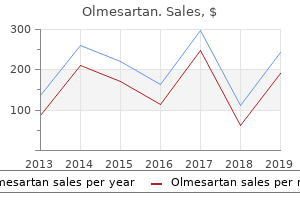
Order generic olmesartanWith all imaging techniques hypertension nos 4019 purchase on line olmesartan, dynamic research are essential to heart attack remixes 20 buy olmesartan 20 mg overnight delivery assess the stability and the osseous-angular relationships to the neural structures arrhythmia questions purchase 10 mg olmesartan mastercard. There is a secondary basilar invagination (basilar impression) with a pontomedullary flexure of lower than 90 degrees blood pressure diastolic high discount 10mg olmesartan visa. The clivus and upper cervical articulation is acute in angulation, indenting the pontomedullary junction. The vertical top of the posterior fossa is decreased by an upward invagination of the squamous-occipital bone. Note the acquired hindbrain herniation with cerebellar tonsils on the C3 vertebral degree. There is an invagination of the higher cervical backbone and cranium base into the cranium. Note the atlantoaxial dislocation with the absence of the anterior atlantal arch elements. In individuals with atlas assimilation and basilar invagination, a rotary subluxation of the atlas on the axis vertebrae can result in vertebral artery distortion, and occlusions are common. Imaging to determine the position of those important vessels and the attainable distortion which will occur with position change must be done prior to surgical treatment. Treatment Strategy Neurodiagnostic imaging17 should be accomplished to reveal the path and mechanics of compression and associated abnormalities in addition to to outline the reducibility of the lesion. Ligamentous reducible pathology corresponding to with inflammatory states or latest trauma must be given a trial of immobilization. A treatment algorithm for problems on this area was first printed by the senior writer in 1980 and was lately up to date by Dlouhy and Menezes. This 13-year-old boy with Down syndrome underwent a dorsal atlantoaxial arthrodesis a 12 months beforehand that failed. We have utilized screw-and-rod constructs in addition to custom contoured threaded titanium loops for occipitocervical fixation with autologous rib graft for the osseous construct. A variety of cranium base approaches have expanded from the essential anterior, lateral, and posterior routes to the foramen magnum. Irreducible dorsal or lateral encroachment is approached dorsally or laterally, respectively. In both circumstance, if instability is present, posterior instrumentation with fixation and fusion is often needed. Basilar impression (platybasia): a bizarre developmental anomaly of the occipital bone and higher cervical backbone with hanging and misleading neurologic manifestations. Craniovertebral junction database analysis: incidence, classification, presentation, and remedy algorithms. Primary craniovertebral anomalies and the hindbrain herniation syndrome (Chiari I): information base evaluation. All 19 patients were either untreated or managed conservatively in a cervical collar. These research and others strongly recommend that, as quickly as cervical myelopathy is established in sufferers with rheumatoid cervical backbone illness, the natural historical past without surgical intervention is grave, and mortality is more frequent than beforehand believed. Additionally, the incidence of cervical myelopathy and due to this fact mortality from myelopathy is in all probability going underestimated in rheumatoid sufferers. Progressive pain, immobility, and weak spot are sometimes attributed to exacerbation of the systemic disease process quite than to neural compression. A historical past of corticosteroid use, seropositivity for rheumatoid issue, the discovering of rheumatoid subcutaneous nodules, and the presence of mutilating peripheral articular illness are all predictive of greater progression of cervical instability and neurologic damage. In a metaanalysis of 1,749 sufferers in the revealed literature, Casey and Crockard4 found that 32% (range, 5. Over half of those affected in this evaluation (17%) had neurologic symptoms or indicators. Joints that finally develop severe destruction normally turn into symptomatic inside the first yr of illness onset. Additional neurologic involvement not referable to the cervical spine contains compression neuropathies corresponding to carpal tunnel syndrome, diffuse sensorimotor neuropathies, and mononeuritis multiplex. These modifications are as a result of the identical host of inflammatory cells and mediators that causes destruction of the joints within the appendicular skeleton.
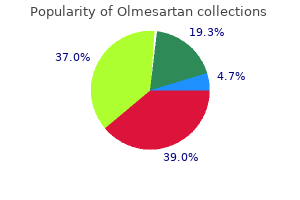
Purchase olmesartan 20mg without prescriptionThe lung is then reinflated under direct endoscopic visualization blood pressure 5080 cheap 20mg olmesartan overnight delivery, and the endoscopic ports are eliminated hypertension kidney infection order olmesartan in india. Smaller 3-0 Vicryl sutures are placed at the dermal-epidermal junction in an interrupted trend to deliver the pores and skin collectively arteria thoracoacromialis olmesartan 10mg generic. Postoperative Care Most sufferers are extubated instantly on the finish of the procedure hypertension guidelines 2013 order olmesartan cheap online. Surgeries of brief length that involve minimal pleural disruption, corresponding to endoscopic thoracic sympathectomies, usually enable the affected person the option of being discharged later that very same day. However, most other kinds of cases require the patient to remain in the hospital at least in a single day for remark. All patients are given an incentive spirometer whereas within the hospital and upon discharge. They are instructed on tips on how to use it and told to continue using it until their first postoperative visit at 10 to 14 days after the operation. The postoperative period is highlighted by pain management, mobilization, and ensuring adequate pulmonary toilet. Immediate Postoperative Complications Immediate postoperative issues can be subclassified into problems of the cardiopulmonary system and complications of the backbone. Long-Term Postoperative Complications Chronic postoperative complications normally contain pulmonary insufficiency or pain syndromes. These issues are prevented by chest tube placement, early affected person mobilization, good pulmonary rest room with incentive spirometry usage, and adequate pain control. Pain control by way of a mix of opiates and nonsteroidal anti-inflammatory drugs can enable the patient to obtain a state of adequate air flow. Pain syndromes ensuing from the transthoracic approach are caused by considered one of two mechanisms. Chronic incisional ache is usually superficial ache that occurs particularly at the site of the incision. Although this ache usually resolves inside a few weeks postoperatively for many sufferers, it might possibly proceed for some. Chronic intercostal neuralgia may be tough to differentiate from a painful radiculopathy; nonetheless, sufferers suffering from radiculopathy preoperatively can often differentiate between their preoperative radicular pain and their postoperative intercostal neuralgia. It is believed that this pressure on the neurovascular bundle may be averted by using flexible endoscopic portals instead of the standard rigid endoscopic portals. If the patient experiences continual intercostal neuralgia regardless of these efforts, regular injections and gabapentin can help the affected person manage these signs. Chronic chest pain syndrome, which includes complaints of generalized chest pain, is believed to result from the disruption of the parietal pleura. This postoperative ache situation is rare and may be very troublesome to deal with effectively when it occurs. Cardiopulmonary Complications Complications of the cardiopulmonary system embody pneumonia, pleural effusions requiring drainage, respiratory distress requiring reintubation, and cardiovascular events. As acknowledged above, all patients obtain a postoperative chest radiograph to look for intrathoracic pathology. The most common postoperative medical finding is a pneumothorax ipsilateral to the facet of operation. Our apply is to depart a chest tube hooked as much as wall suction at a pressure of �20 cm H2O. The chest tube is left in place till the chest tube output decreases to less than 20 mL per 24 hours. If a pneumothorax persists for greater than 5 days, the affected person could need to return to the operating room for a physical or chemical pleurodesis. Other types of intrathoracic pathology that can complicate the immediate postoperative period are hemothorax, chylothorax, atelectasis, and rigidity pneumothorax. Similar to the remedy of a persistent pneumothorax, a persistent hemothorax or chylothorax requires reoperation; however, if the suspicion for these pathologies being present is excessive, return to the operating room normally occurs in a shorter period, corresponding to by postoperative day 2 or 3, as these pathologies are much less likely to resolve than a pneumothorax. Atelectasis requires extensive patient mobilization and pulmonary rest room to obtain decision of the issue. Tension pneumothorax is an unusual complication, which ends up from insufficient closure of the chest walls. Its strengths are its ability to present the surgeon with a large visual field within the thoracic cavity, as well as the power to function on multiple thoracic spinal segments.
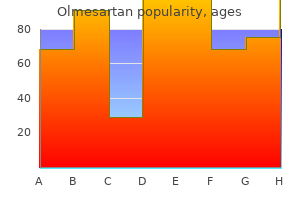
Buy olmesartan 20mg mastercardThis nonetheless leads to hypertension vitamins generic olmesartan 20mg overnight delivery in- 12 Retropharyngeal Approach to the Occipital-Cervical Junction blood pressure up discount olmesartan 20 mg visa, Part 2 81 blood pressure medication nerve damage buy 10mg olmesartan overnight delivery. The caudal end of the graft is wedged into position over the superior epiphysis of C3 using a 5-mm curved osteotome as a prying lever and a bone mallet to place the graft hypertension 1 symptoms purchase olmesartan overnight delivery. An autograft or allograft of iliac bone crest can be utilized because the strut graft between C1 and C2. Because the arch of C1 is often mobile, it may be very important measurement the graft with the arch in a neutral position to avoid under- or oversizing the graft. A tricorticate iliac crest strut or allograft humerus strut is notched at the cephalic finish so that the notch engages the anterior C1 arch. The flat caudal end of the graft is then levered into position over the superior epiphyseal floor of the C3 physique. A slim curved osteotome can serve as the lever and be worked like a shoehorn to position the decrease finish of the graft to effect a "press match" of the assemble. Manual traction on the mandible or skull tongs can assist in placement of the graft. Nonrigid bicortical screw fixation through the graft and C1 arch and C3 body is most well-liked as a result of the screws may be angled as wanted. Either autograft or allograft bone can be utilized depending on particular person patient necessities. Allograft tibia or humerus has been discovered to be in regards to the correct dimensional width and affords circumferential cortical bone to bolster the energy of the support strut. The medullary cavity is first cleared of trabecular bone and filled with autogenous bone from the resected C2 physique, if applicable, or iliac crest to facilitate bone fusion. Preemptive tracheotomy is the preferred tactic when the patient is immobilized by myelopathic quadriparesis. Upper airway obstruction caused by delicate tissue swelling within the postoperative interval is a significant consideration with this process, particularly with myelopathic and debilitated sufferers. To ensure a reliable upper airway, endotracheal intubation may be required for a quantity of days with the patient in a head-up place till the edema resolves. A positive end-expiratory stress of 5 cm H2O on the ventilator tends to prevent atelectasis. Nursing the patient in a rotokinetic mattress can help with pulmonary drainage in chosen sufferers. Nutritional Support Optimal vitamin is essential to the recovery of any stressed patient. The pharyngeal and higher airway edema that occurs following this procedure impedes swallowing for several days and even weeks. Maintenance of the metabolic stability is facilitated by preoperative placement of a feeding gastrostomy/jejunostomy to ensure enteric alimentation. Effectively supplying dietary assist helps to avoid mucosal bacterial 82 I Occipital-Cervical Junction translocation and sepsis; it also helps to promote earlier rehabilitation of these sufferers. All patients complain of dysphagia to some extent immediately postoperatively; it clears spontaneously inside 1 to 2 weeks of surgery in most sufferers. This risk can be minimized with broad release of the fascial planes, thus minimizing the diploma and pressure of retraction wanted for visualization. Prolonged dysphagia will ultimately resolve as properly, and the feeding access can be eliminated after a caloric intake evaluation confirms sufficient oral consumption. Nonunion is a selected concern in sufferers with irregular bone physiology because of advanced inflammatory situations as well as ongoing immunolytic and steroid medical therapies. Some patients complain of persistent ache or regression towards their preoperative neurologic baseline. This emphasizes the significance of avoiding or minimizing resection of the inferior portion of the arch throughout publicity. Removal of the strut is required and a posterior fusion and instrumentation can be performed, typically at the similar session. The use of implanted or exogenously utilized bone stimulation gadgets can be used on the discretion of the surgeon.
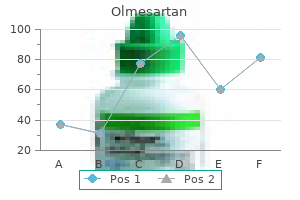
Discount olmesartan 40 mg amexThe construction that conveys these cells beneath the epiblast is the neurenteric canal blood pressure yahoo purchase olmesartan with american express. Resegmentation of the Vertebral Column the distinct nature of every somite (or main segment) as a developing unit changes prehypertension heart attack buy olmesartan 20 mg fast delivery. After resegmentation pulse pressure 68 buy cheapest olmesartan, each vertebra is composed of sclerotomic contributions from two adjoining somites: the caudal half of a cranial sclerotome and the cranial half of the next-caudal sclerotome blood pressure medication dosage too high order olmesartan 20 mg online. Disks type at the midportion of each sclerotome, with the notochord around which centra manage contributing to the nucleus pulposus. Craniocaudal segmentation during somitogenesis is related to a signaling cascade including receptors responding to the Notch transmembrane protein. Notch promotes an oscillating sample of gene expression that alternates craniocaudally and drives resegmentation by specifying cranial and caudal halves of sclerotome. Primary Neurulation the underlying notochord affects the area of ectoderm mendacity above it, making it thicken along the anteroposterior axis. By the top of gastrulation, a stripe of ectoderm (the neural plate) is alongside the middle side of the trilaminar disk. Lateral aspects (neural folds) stretch above the invaginating medial neural plate and fuse alongside the midline for neural tube closure, referred to as major neurulation. The anterior neuropore closes on about postovulatory day 24 and the posterior neuropore closes on about day 26. Errors in main neurulation end in neural tube defects, and abnormalities in disjunction end in spinal lipomatous lesions (or dorsal dermal sinus tracts in more focal failures of disjunction). If mesenchymal parts from surrounding mesoderm proliferate while the connection between cutaneous ectoderm and neural ectoderm is obliterated too early, intradural anomalies such as intramedullary lipomas and lipomyelomeningoceles20 occur. The Sonic hedgehog (Shh) signaling molecule is necessary in ventral induction of the floor plate and motor cord (the basal plate),21 whereas the reworking progress factor- Chondrification and Ossification Sclerotomic mesenchyme starts to differentiate into cartilage on the sixth week of gestation, and by the tenth week ossification facilities have been established and begin to convert cartilage into bone. Ossification of vertebral our bodies follows a special temporal pattern than the ossification of neural arches. Ossification of the neural arches progresses craniocaudally from the cervical column. These malformed vertebra lead to an irregular curvature of the backbone in the coronal plane, which can proceed to worsen even after skeletal maturity. The true incidence of congenital scoliosis is unknown as a outcome of minor deformities usually go undetected. Winter et al33 developed a classification system for congenital spinal deformities based mostly on the embryological growth of the spine. This system divides the anomalies into (1) failures of formation, (2) failures of segmentation, and (3) combined anomalies. Using this system, Winter et al have been capable of classify as much as 80% of all abnormalities. Normal progress of the backbone happens on the finish plates on the higher and lower surfaces of the vertebral bodies. Congenital vertebral anomalies can cause useful deficiency of the growth plates on one or each side of the backbone. Many patients are asymptomatic, or they might current with abnormal backbone curvature and undergo a scoliosis workup. Patients with vital scoliosis may develop neurologic deficits, developing ache or weak spot. In instances of extreme spinal deformity, pulmonary compromise might result from impeded chest wall movement. X-rays show a sharply angulated, single curve or focal scoliosis, which serves as a significant diagnostic clue that there could additionally be a hemivertebra. There are three kinds of hemivertebra (unsegmented, semisegmented, and absolutely segmented), that are classified each by the connection of the hemivertebra to the adjacent vertebrae and by whether the related disks are morphologically normal. A semi-segmented hemivertebra is fused to either the decrease or upper vertebra and has just one development plate. A absolutely segmented hemivertebra has a full progress plate on both aspect and is the commonest type of hemivertebra. For example, paired bilateral hemivertebrae can end result in a "balanced" scoliosis because the curves cancel out. However, a number of unilateral hemivertebra would result in an unbalanced and uncompensated scoliotic curve. The totally segmented hemivertebra acts like an enlarging wedge and is situated at the apex of the convexity of the scoliosis.
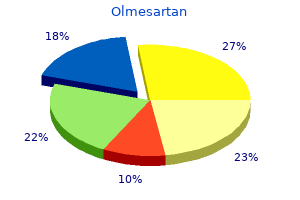
Buy olmesartan once a dayFrequently blood pressure and diabetes best 10 mg olmesartan, a portion of the pedicle might want to excel blood pressure chart generic olmesartan 40mg online be tapped hypertension bradycardia buy olmesartan pills in toronto, as a outcome of blood pressure 220 120 purchase olmesartan discount the dense cortical bone. The screw can then be placed, with palpation of the borders of the pedicle, once more with the balltip probe, to verify Cervical Spine Lateral Mass Screw Placement Lateral mass fixation has turn into the mainstay for stabilization of the subaxial cervical spine. Various techniques have been described including those of An, Magerl, Anderson, and RoyCamille. Preparation of the insertion website includes clear exposure of the boundaries of the lateral mass. After identification of the correct starting point, we suggest creating a small pilot hole with a 2-mm spherical bur or awl. The lateral mass screws must be directed 30 to 40 degrees rostrally and 20 levels laterally. A mounted cease drill bit should be used and measured to the screw size as measured on the preoperative imaging. After drilling the outlet, a nice, blunttipped probe is used to verify the integrity of the walls of the outlet and to verify that the cortex has not been penetrated. The pedicle finder is removed, and a pedicle probe is used to palpate 5 distinct bony borders, including a ground and four walls to ensure no bony breach. The appropriate size of the screw is determined by measuring the length of this probe utilizing a clamp. The place to begin for lateral mass fixation is 1 mm medial to the center of the lateral mass. The medial boundary is the inflection of the lamina and aspect, the lateral boundary is the edge of the articular mass, and the superior and inferior boundaries are the respective aspect joints. The mass screws should be directed 30 to 40 degrees rostrally and 20 levels laterally. The starting point for the C7 pedicle is 1 mm inferior to the midportion of the facet joint with 25 to 30 degrees medial angulation and perpendicular to the posterior arch. Translaminar Screw Placement In cases with unfavorable upper thoracic pedicle anatomy, translaminar screws present an effective alternative to pedicle screw fixation. The trajectory is roughly alongside the angle of the ipsilateral lamina, with the target being the intersection of the ipsilateral transverse process and superior aspect. To place bilateral translaminar screws, the beginning factors should be slightly totally different cephalad caudal, and the lateral trajectories must be barely divergent, to keep away from collision of the screws. Furthermore, intact bony arches are wanted, and as such this method is used relatively occasionally. Thoracic Pedicle Screw Placement the identical ideas used for C7 pedicle screw placement apply for placement of higher thoracic spine pedicle screws. Wide exposure of the lamina and lateral mass (C7) and transverse processes (T1�T2) is carried out with removal of the medial side of the transverse process of T1�T2 to enable the pinnacle of the pedicle screw to be seated. The start line of the T1 to T2 pedicles is extra lateral and more inferior than for the lower thoracic spine. Once a posterior cortical breach is made with a bur or an axe, a pedicle finder or a highspeed drill is placed into the base of the pedicle alternatively. Medial angulation is required for entry of the pedicle into the vertebral physique, which averages ~ 30 levels on the T1 level; subsequent inferior levels are more variable with T2 between 15 and 25 levels and T3 and below within the 5-degree neighborhood. Rod Placement and Fusion Surface Preparation After the screws are seated, a rod template is bent to the wanted length. The start line is the junction of the contralateral spinous process and lamina. The trajectory is along the angle of the ipsilateral lamina, aiming for the intersection of the ipsilateral transverse process and superior facet. To place bilateral translaminar screws, the beginning factors need to be slightly totally different cephalad-caudal, and the lateral trajectories should be barely divergent, to keep away from collision of the screws. The start line is the midpoint of the transverse course of (rostral-caudal) and the junction of the transverse course of and lamina (medial-lateral). The medial angulation averages ~ 30 degrees at the T1 degree; subsequent inferior ranges are more variable, with T2 between 15 and 25 degrees and T3 and below in the 5-degree neighborhood. Caution is taken with these units to not exert too much pressure as a end result of pullout and failure of the bone�screw interface can simply occur.
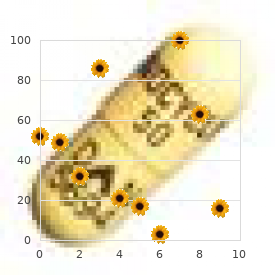
Cheap olmesartan 40mg on-lineThe fascial attachment to the spinous process is divided simply off the midline to introduce a periosteal elevator on the most dorsal superior margin of the spinous process pulse pressure 30 mmhg proven 20mg olmesartan. The muscles are stripped from the spinous course of superficial to deep using a periosteal elevator and could be continued over the laminar floor till the medial facet joint heart attack 40 year old male purchase genuine olmesartan on line. This helps keep away from muscle bleeding and damage hypertension quality improvement buy olmesartan without prescription, and insertion of a gauze sponge can facilitate the periosteal dissection heart attack vs heart failure generic olmesartan 10 mg on-line, particularly the medial to lateral dissection to expose the facets. The knife is taken all the way down to the spinous process, where the lumbodorsal fascia is encountered. We use a mix of scraping the sharp finish of the Cobb in a subperiosteal method and heavy scissors to cut any remaining muscle or fascial attachments. The use of Ray-Tec sponges may help dissect the soft tissue in a subperiosteal method. Although extra bleeding is encountered, this sharp dissection preserves the muscle integrity and avoids excessive cautery. It has been our expertise that excessive cautery within the muscle and the bony elements could cause thermal harm with irritation of the adjacent nerve roots. Complex regional ache syndromes and causalgia can damage an otherwise well-performed operation if excessive cautery is used. This can generally occur in patients with occult spinal dysraphism, and is also a potential pitfall in patients with posterior factor fractures. Additionally, in some patients, the interlaminar house may be quite wide, by which case warning have to be exercised to avoid inadvertent penetration into the spinal canal. The extent of the lateral dissection is decided by the operation, and is elaborated in subsequent chapters. For a easy hemilaminectomy and diskectomy, a unilateral exposure that extends just to the side joint is usually sufficient. On the opposite hand, a posterolateral fusion requires a wide bilateral publicity that utterly exposes the side joint and the transverse processes, which lie more laterally and deep. There are quite a few self-retaining retraction methods that might be utilized for sustaining the exposure. Once dissection and retraction of paraspinous muscles are full, the surgeon has a full view of the posterior spine. Although the spinous processes within the thoracic spine level inferiorly, this turns into less obvious within the lumbar backbone. Indeed, on the decrease lumbar ranges, the spinous processes point directly posteriorly. Each vertebra articulates with its neighbor rostrally and caudally via the intervertebral disk and the side joints. Each aspect consists of the inferior articular means of the vertebra above and the superior articular process of the vertebra beneath. An important structure is the pars interarticularis, a portion of the lamina that gives the bony connection between the superior and inferior articular processes of an individual vertebra. The transverse processes project laterally from the level of the superior articular aspect. The essential ligamentous buildings include the supraspinous and interspinous ligaments, the ligamentum flavum, the facet capsule, and the intertransverse ligament. The iliolumbar ligaments run from the transverse processes of L5 to the iliac crests and help stabilize this space. The dorsal surface is irregular owing to the presence of irregular crests overlying the fused spinous, articular, and transverse processes. On both aspect of the sacrum are four pairs of foramina for the passage of the dorsal rami of the sacral nerve roots. Moreover, outpatient physical therapy is prescribed for all our postoperative backbone patients. In terms of general issues with the posterior lumbar approach, extensive muscle dissection and lack of respect for tissue plans can result in devascularization, atrophy, and sophisticated regional ache syndromes. Closure Prior to closure, the selfretaining retractors are loosened and meticulous hemostasis is carried out. The surgeon might resolve to go away a drain, largely based mostly on the diploma to which hemostasis can be achieved. References:
|


